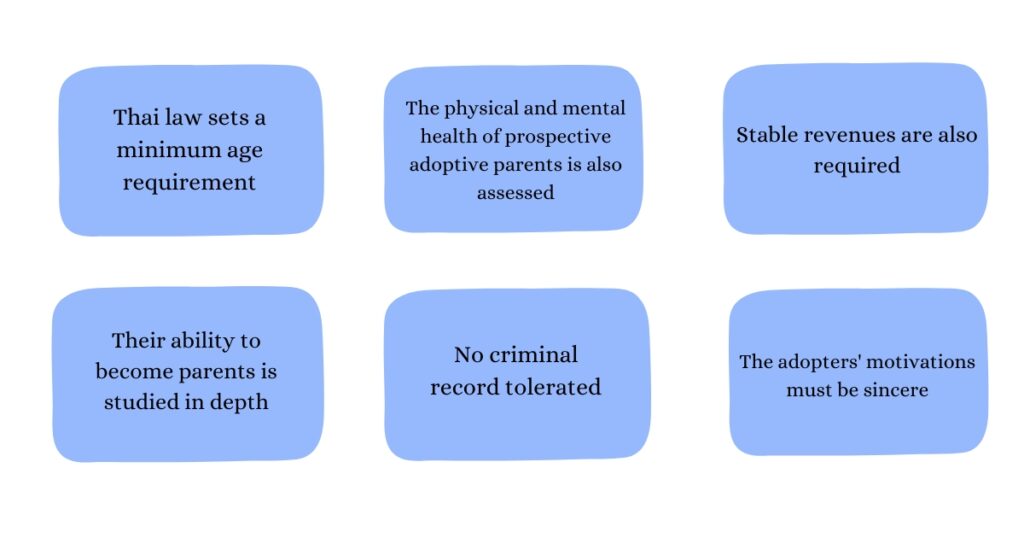Call us now:

Adopting in Thailand.
Adopting in Thailand is a delicate matter, requiring a thorough understanding of the country’s laws and customs. Thailand’s procedures are designed to protect the rights of children, adoptive parents and biological families.
Before taking any steps, it’s important to carefully study the specifics of local adoption. By understanding the legal and cultural ins and outs, prospective parents will be able to navigate the administrative steps serenely, while ensuring the child’s well-being.
Table of Contents
What are the different types of adoption in Thailand ?
In Thailand, there are two main ways of adopting a child: national adoption and international adoption.
- National adoption: National adoption involves the adoption of a Thai child by Thai parents resident in the country. This process is regulated by Thai law and follows specific procedures defined by the competent authorities.
- International adoption: International adoption involves the adoption of a Thai child by foreign parents not resident in Thailand. This process is also governed by Thai law and international adoption agreements. Foreign families must follow specific procedures and obtain approval from the relevant Thai authorities, as well as from their country of origin.
It is essential to note that adopting in Thailand is governed by strict regulations designed to protect the rights of the child, the biological parents and the adoptive parents. Families interested in adopting in Thailand should contact the relevant authorities and accredited adoption bodies for precise, up-to-date information on the adoption processes available.
What is the legal framework governing adoption ?
Adoption in Thailand is governed by a complex set of laws and regulations :
- The Thai Civil Code defines the fundamental principles of adoption in the country, including eligibility requirements, the legal process and the rights of stakeholders.
- The Adoption Act sets out more specific guidelines to facilitate the adoption process. It covers issues such as the eligibility of adoptive families, the administrative steps to be followed and the duties of biological and adoptive parents.
- The Thai Central Authority supervises international adoptions in accordance with national legislation and international agreements. It ensures that legal and ethical standards are uniformly applied.
- Thailand has ratified several conventions, such as La Haye Convention aimed at harmonizing cross-border adoption processes. These treaties establish common protocols to protect the rights of minors and prevent child trafficking.
Most adoptions in Thailand are undertaken with the support of government-approved agencies. These agencies accompany families and ensure that adoptions comply fully with the law.
How to adopt in Thailand: Criteria you must meet
There are many requirements for adopting in the kingdom, depending on the type of adoption (national or international) envisaged. Here are the main requirements:

How to adopt in Thailand: Documents required for your application
Adopting in Thailand generally requires a multitude of documents and information essential to initiating and completing the adoption process. Specific requirements may vary according to the type of adoption (national or international) and the particular guidelines of the relevant Thai authorities. The following is a general list of documents and information commonly required to adopt in Thailand:
- Adoption forms: Prospective adoptive parents must complete and submit the official adoption forms provided by the relevant authorities or licensed adoption agencies.
- Identity documents: Certified copies of passports, identity cards, birth certificates and other identity documents of the adopters must be included in the application.
- Proof of marital status: Married couples must provide certified copies of their marriage certificate. Single people must establish their marital status in accordance with legal requirements.
- Proof of income and financial status: Documents such as bank statements, tax returns and employer certificates may be requested to assess the adopters’ financial stability.
- Medical reports: Physical and psychological check-ups may be required.
- Criminal records: Criminal record extractors or background checks may be required to demonstrate the absence of criminal convictions.
- Psychosocial assessments: In some cases, psychosocial analyses may be required to assess the adopter’s breeding capacity.
- Letters of recommendation: Letters of reference from trusted persons may be requested to support the adopters’ application.
- Evidence of adoption training: attendance at adoption courses may be required, with justification.
It should be noted that this list is not exhaustive and that conditions may vary according to the situation. Interested families should contact accredited bodies for precise instructions on how to put together an adoption file.
Get expert legal guidance.
How to adopt in Thailand: Step-by-step procedure
The procedure for adopting in Thailand may vary according to the type of adoption (national or international) and the laws in force. Generally speaking, here are the main steps to follow:
- Step 1: Prospective parents need to find out about legal requirements and eligibility criteria. They may need to undergo adoption training and gather the necessary documents.
- Step 2: They can choose to go through an accredited adoption agency in Thailand, which will guide them through the process.
- Step 3: Once the file is complete, they must submit it to the relevant authorities, such as the Ministry of Social Affairs or the Child Protection Department.
- Step 4: The authorities examine the file carefully to ensure compliance with the law, and may carry out additional checks.
- Step 5: If the dossier is accepted, the authorities seek to match the adopters with a child corresponding to their criteria.
- Step 6: The prospective parents may have to travel to Thailand to meet the child and finalize the process, with the support of an agency.
Finally, an official court decision concludes the adoption procedure.
